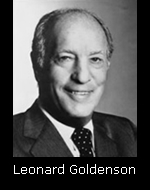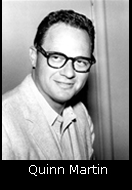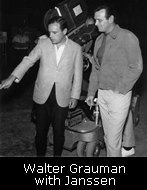
In September of 1960, David Janssen was parlaying his recent RICHARD DIAMOND success into a movie career. With two films already in the can, Janssen was filming his third, RING OF FIRE in the Pacific Northwest.

 In
Brentwood, California writer-producer Roy Huggins was putting pencil to paper.
The Western genre was popular at the time, and Huggins was attempting to
take a Western hero, a loner who had no permanent residence or commitments,
and put him in a contemporary setting. This idea germinated into a 6-page
outline for a television series called THE FUGITIVE. The idea languished
during Huggins' short lived job as 20th Century-Fox's V.P. of TV Production
where his boss hated the idea of an accused killer running around the country.
But Huggins finally found a friend of the concept in ABC's president Leonard
Goldenson in 1962. Goldenson championed the project despite some skepticism
from his underlings and ordered up a pilot.
In
Brentwood, California writer-producer Roy Huggins was putting pencil to paper.
The Western genre was popular at the time, and Huggins was attempting to
take a Western hero, a loner who had no permanent residence or commitments,
and put him in a contemporary setting. This idea germinated into a 6-page
outline for a television series called THE FUGITIVE. The idea languished
during Huggins' short lived job as 20th Century-Fox's V.P. of TV Production
where his boss hated the idea of an accused killer running around the country.
But Huggins finally found a friend of the concept in ABC's president Leonard
Goldenson in 1962. Goldenson championed the project despite some skepticism
from his underlings and ordered up a pilot.
Huggins decided for personal reasons not to accept the weekly responsibility
for the show and producer Quinn Martin, who'd had a success with THE UNTOUCHABLES,
was given the nod to take over and produce the pilot.
Janssen, by now, had not exactly set the town on fire with his transition to the big screen. His starring roles in films like DONDI, KING OF THE ROARING TWENTIES, and TWENTY PLUS TWO had been released and were forgettable, bordering embarrassing.

 But despite
these disappointments, Janssen's name came up during the casting
discussions for the lead of Dr. Richard Kimble. Quinn Martin, who now had
creative control, had been an editor at Universal in the 50's and had seen
a lot of film of Janssen pass through his moviola. He remembered him as an
actor who would never "fade into the woodwork." Huggins may have also put
in a good word; he'd produced a strong guest-starring role Janssen did in
1956 on the Warner Brothers series CONFLICT. And more recent guest shots on ADVENTURES IN PARADISE (in 61) and FOLLOW THE SUN (62) occurred while Huggins headed 20th Century-Fox's TV division.
But despite
these disappointments, Janssen's name came up during the casting
discussions for the lead of Dr. Richard Kimble. Quinn Martin, who now had
creative control, had been an editor at Universal in the 50's and had seen
a lot of film of Janssen pass through his moviola. He remembered him as an
actor who would never "fade into the woodwork." Huggins may have also put
in a good word; he'd produced a strong guest-starring role Janssen did in
1956 on the Warner Brothers series CONFLICT. And more recent guest shots on ADVENTURES IN PARADISE (in 61) and FOLLOW THE SUN (62) occurred while Huggins headed 20th Century-Fox's TV division.
Janssen
was cast and the pilot began production in Tucson, Arizona on Nov 27,
1962 with a strong director Walter Grauman at the helm and with a
script
by Stanford Whitmore which hit the right emotional notes. ABC bought the
show for Fall of 1963.
 Alan A. Armer
was hired to produce the first season (he would stay on for
3 of the 4) and rode herd on the scripts, maintaining his very high standard
in the process.
Alan A. Armer
was hired to produce the first season (he would stay on for
3 of the 4) and rode herd on the scripts, maintaining his very high standard
in the process.
Quinn Martin had established the 4-act break plus epilog structure on his first QM Productions series in 1961-62, THE NEW BREED. This formula was repeated on THE FUGITIVE (and became the emblematic signature on most future QM shows).
Each episode also began with an introductory coda, which would soon become familiar to audiences. Narrated by the husky-voiced William Conrad, this introduction was quite faithful to the backstory outlined in Roy Huggins' original 1960 proposal. The haunting theme music, composed by Pete Rugolo, also helped immeasurably to emotionally engage viewers.
The show premiered on September 19. 1963. Audiences were slow to discover the show, but it did catch on and by season's end it was voted by TV Guide as the best new show of the season. Janssen received an Emmy Nomination (but did not win) for the role.
Popularity only grew the next two years and for the 65-66 season, Janssen was again nominated but not given an Emmy. However, in this same year, the show won the statue for the "Best Dramatic Series."
For the final 66- 67 season, several changes were instituted. Producer Armer, so influential in the creative quality control, went over to another QM show, THE INVADERS. The atmospheric black-and-white, which had so complemented the mood of the show, gave way to the network color standard. But there was another more serious visual change if you looked closely. The grueling demands of the show had started to take its toll on its lead. Janssen, by nature of the concept, was in almost every scene of the series. He'd shot 12-15 hours per day, 7-8 days per show, 30 shows per year for 3 years. He had matured immeasurably as as actor, given such good writing and situations to play, but he was exhausted. He'd complain he'd go home to study his lines for the following day's work, but would "fall asleep in his mashed potatoes" instead.
Janssen was given the option to go on for a 5th year but declined and plans were made by Christmas 1966 to end the show with a 2-part finale. These shows completed filming on March 31, 1967 and were kept on ice to air on successive Tuesdays in late-August 1967 after summer reruns.
June 4's Emmy ceremony once again gave Janssen nomination honors but again denied him his, by now, well-deserved win. He lost a 2nd time to Bill Cosby for the I SPY series, and would never again be nominated for another major acting award. His failure to receive an Emmy, especially for the Dr. Kimble role, seems in retrospect to be a serious omission.
Excitement built during June, July, and early August as audiences were promised Kimble would be proven innocent but details were withheld on how this would play out. On August 29, all was wrapped up, and "the day the running stopped" had the distinction of garnering a Nielsen estimate of a 72% share of the televisions on that night. This remained the highest rated single episode of a series until the DALLAS "Who Shot J.R.?" show broke its record over 13 years later.
 Credit for the success of THE FUGITIVE must also be given to an unsung hero
of the show, Barry Morse, who did wonders with the role of the obsessed Indiana
police Lt. Gerard. Appearing in only 1/3 of the 120 produced episodes, the
viewer always felt fear that his ominous presence might be lurking around
any corner Kimble turned. Quite remarkable also was that he created this
U.S. Midwestern persona disguising that in real life he spoke with an unmistakable
British accent!
Credit for the success of THE FUGITIVE must also be given to an unsung hero
of the show, Barry Morse, who did wonders with the role of the obsessed Indiana
police Lt. Gerard. Appearing in only 1/3 of the 120 produced episodes, the
viewer always felt fear that his ominous presence might be lurking around
any corner Kimble turned. Quite remarkable also was that he created this
U.S. Midwestern persona disguising that in real life he spoke with an unmistakable
British accent!
David Janssen did a lot of the finest work of his career on his four year run as THE FUGITIVE. Many feel it was to be his professional nexus.
Created by: Roy Huggins
Produced by: Alan A. Armer (seasons 1-3), Wilton
Schiller, John Meredyth Lucas (season 4)
Theme Music: Pete Rugolo
Other recurring cast:
Barry Morse as Lt. Philip Gerard
Bill Raisch as Fred Johnson, the one-armed man
Jacqueline Scott as Donna Taft
Paul Birch as Captain Carpenter
Narrator (Act I and Epilogue): William Conrad
Announcer (Main Titles): Dick Wesson
(note: Dick was also the voice of WALT DISNEY'S WONDERFUL WORLD OF COLOR, and 3 other early QM Shows--THE NEW BREED, THE INVADERS, and 12 O'CLOCK HIGH.
Hank Simms, a more frequent QM voice artist, has been erroneously reported in published sources to have filled this role on THE FUGITIVE. However, his work for the producer was on his future shows, most notably THE FBI, THE STREETS OF SAN FRANCISCO, CANNON, BARNABY JONES, and DAN AUGUST.)
Syndication and DVD Rights: CBS/Paramount
PILOT: FEAR IN A DESERT CITY, which filmed in Tuscon and Los Angeles for 11 days beginning 11/27/62, served as the pilot for the show. An original non-broadcast version of this episode with different titles, music, and some other minor scene changes exists with collectors.
Click the season number to view details of each episode.
| Season 1: | 9/17/63 - 9/8/64 | Tuesday 10p-11p | 30 episodes |
| Season 2: | 9/15/64 - 9/7/65 | Tuesday 10p-11p | 30 episodes |
| Season 3: | 9/14/65 - 9/6/66 | Tuesday 10p-11p | 30 episodes |
| Season 4: | 9/13/66 - 8/29/67 | Tuesday 10p-11p | 30 episodes |